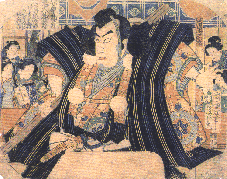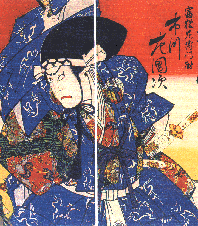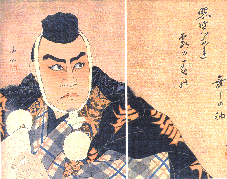
NOVEMBER
"KAOMISE"PERFORMANCES
KABUKI-ZA
Evening Programme
Toyata Monogatari
Kanjincho
Shibahama no Kawazaifu
Ami Uch
KABUKI-ZA
Click here for Matinee Programme
「勧進帳」武蔵坊弁慶 市川団十郎(9代)明治2年3月市村座
KABUKI-ZA
Matinee Programme
1). "Toyata Monogatari".
This is the second item commemorating the death of Band Mitsugoro VII and Mitsugoro VIII, and stars Bando Mitsugoro IX in the leading role. It is one act from the long play, "Gosho Zakura Horikawa Youchi", written by Bunkodo and Miyoshi Shoraku and first staged in 1937. For many years this act was not performed but it was revived by Mitsugoro VII at the Tokyo Gekijo in 1947, and since then it has remained in the repertoire of the Mitsugoro line of actors. (Ichikawa Danshiro is the only non-related actor to have performed the play in 1982.)
The story is set in the late 12th century during the civil wars between the Heike and Genji clans. Yoshitsune is a general on the Genji side but his wife, though in all other respects innocent, is the daughter of a Heike warrior. For this reason, Yoshitsune has been ordered to kill her and to submit her head as proof of his loyalty, something which he is loath to do. In the previous act known as, "Benkei Joshi", his wife's life is saved by the substitution of another woman's head, and in this act she is disguised as a household maid to keep her identity hidden. To allay Genji suspicions yet further, Yoshitsune has installed his mistress in the household, the beautiful dancer Shizuka Gozen, and all seems well until Shizuka's brother, Toyata, comes to visit. Toyata is a rascal who has been disowned by his father, and although he has recently performed some service for which Yoshitsune is indebted to him, he is still in collusion with the evil general Kajiwara. On his current spying mission he realises the true identity of the maid, (i.e. Yoshitsune's wife), and is in the middle of writing to inform Kajiwara when Shizuka stops him and they fight. This does little good however , and it is not until their mother appears and stabs Toyata that he has a profound change of heart, confesses his past sins and lets them know of an enemy attack due to take place that night. Toyata's mother then reinstates him as a full member of the family and, though mortally wounded, Toyata goes off to do battle with the enemy forces in a grand, "tachimawari" fight scene.
This play sounds as if it should be interesting, but on stage this month it isn't. It was originally performed as a puppet play, and as such it retains the use of a narrater and shamisen player from the Gidayu school, the same form of accompaniment that's found in the Bunraku theatre. The assimilation of plays that were originally written for the puppets into the Kabuki repertoire is a common phenomenon, and it often results in a fascinating tension between the live actor and the Gidayu musicians which is unique and extremely effective. The intimate relationship between the shamisen and the actor's speech or movements for example, can be thrilling to watch and to listen to. However, this cannot make up for a performance which lacks dramatic depth or good acting. Too often these, "maruhon" plays are lengthy and tedious because the actors seem incapable of communicating real human emotion. Because it is influenced by the puppets, the style of acting is very unnaturalistic, and sometimes this appears to form a barrier through which the human actors cannot make themselves heard. Perhaps they have so much to worry about - the movements, the precise speech patterns, the difficult dialogue itself, even preserving the family tradition - that they forget to act! There is nothing wrong with stylisation. Most of the truly moving experiences I've had in the theatre have come from watching highly stylised plays or dances. But it is always up to the actors to breathe life into such works and to communicate through the acting style.

「勧進帳」富樫左衛門市川左団次(初代)明治23年5月新富座
2). "Kanjincho".
This play is an acknowledged masterpiece and is the most frequently performed of any in the Kabuki repertoire. But perhaps because it is so often staged it can sometimes seem "tired" and lack-lustre. It all depends on the cast.
"Kanjincho" is a work of immense depth and it requires great ability from the leading actor in terms not only of elocution, acting and dancing, but also of mere stage presence. The character of Benkei must be larger-than-life, and whether he is angry, sad or even drunk, he must at all times be impressive. Yet, although this is one of the "Kabuki Juhachiban", (the eighteen favourite plays chosen by Ichikawa Danjuro VII as typifying his family's acting tradition, the character of Benkei is more fully-rounded and more convincingly human than any other in this collection, and we are allowed the chance to observe him in a variety of different moods and different circumstances. For 80% of the time we are concetrating on this character alone, and so it isn't suprising that to be called a "Benkei yakusha", ("a Benkei actor") ,is one of the supreme compliments for any Kabuki actor specialising in powerful male roles.
Since the 2nd World war the part of Benkei has been associated mostly with the three great brothers, Ichikawa Danjuro XI, Matumoto Hakuo and Onoe Shoroku II, and today it is still played most often by their descendants, Danjuro XII, Matumoto Koshiro IX, and Nakamura Kichiemon II. This month, it is Kichiemon in the leading role, and in January at the National Theatre Koshiro is down to play it again.
The production this month is undoubtably good, and along with Kichiemon it has what muhst be close to an ideal cast in the other very important roles of Togashi and Yoshitsune. These characters are played by Kikugoro and Baigyoku respectively. No matter how brilliant the actor playing Benkei, if the character of Togashi is seen to be weak then the performance suffers greatly for there will be no effective foil. Benkei seems all the stronger if his opponent is also strong. Furthermore, Togashi is in many ways a fascinating and tragic character in his own right and for any actor to fail to convey his complicated psychology would be to ruin much of the performance. Togashi is a loyal and upright warrior whose only weakness is his admiration for an enemy's heroism, a weakness he is willing to pay for with his own life. He is one of the most dignified characters in the Kabuki repertoire, all the more human for showing sympathy. This month, Kikugoro is excellent in this role, revealing a serious gravity and depth to his acting which sometimes seems to be missing when he doesn't concentrate. The "yamabushi mondo", ("interrogation of the yamabushi"), section is thrilling, (though on the second occasion I saw it, it was Kichiemon who seemed a little slow). In particular, at the moment when one of Togashi's soldiers notices the figure of Yoshitune lagging behind the others and alerts Togashi, thereby forcing him to react, Kikugoro is superb! Upon hearing this news Togashi jumps up and rushes to confront the so-called priests. Just before he does so however, he will, depending on the actor, hurl his fan into the air behind him. This is exciting to see and it seems unfortunate that many actors choose not to perform this action. Much of the role of Togashi is indeed internalised for he must keep his own feelings hidden throughout most of the play, but this is a moment of extreme tension which is given greater impact by this sudden and explosive touch. Kikugoro does hurl the fan high into the air. In other respects, Kikugoro's voice, his facial expressions, his body movements and poses including his handling of the trailing "nagabakama" costume, are all near-perfect.
Baigyoku is also excellent as Yositsune. This is not so important a role as the other two although the character must demonstrate a refined nobility and compassion that makes him a worthy master. All of Benkei's efforts are, afterall, made on his behalf. At the beginning of the "yomiage" section, just as Benkei starts his improvised reading of the subscription scroll and Togashi edges up towards him to try and peek at the scroll, Yoshitsune will sometimes lift a hand to his hat as though peering up at the others. Again, not every actor will do this, perhaps because most cannot be bothered with such a small action. However, the action is important, albeit small, because it adds a sense of desparation to the tense situation - even Yoshitsune himself cannot help but watch what is happening. Baigyoku is good here, and does just enough to be effective without distracting attention.

「勧進帳」武蔵坊弁慶 松本幸四郎(7代)昭和10年初秋
「照覧あれ 霞の春の 舞の袖」
Later, when they have all successfully passed through the barrier and are a safe distance from it, Yositsune, can at last resume his rightful position as lord. This is the famous reconciliation scene between Yositsune and Benkei when the former forgives his retainer for having struck him with his staff. It is the first time in his life that Benkei is moved to tears by his lord's kindness, and it is the most important scene in the play for the actor playing Yositsune. Baigyoku is very well suited to this role and the sense of vulenerability which he so successfully conveys makes the scene quite moving. The famous moment is when he extends his hand in forgiveness towards Benkei, and then lifts it to his eyes in a traditional gesture of crying. Although this role is often given to "onnagata", (actors who specialise in female roles), Baigyoku as a male-role specialist gives it a slightly tougher edge which works just as well, if not better. We can still believe that Yoshitsune is also very moving: born to a family of warriors, Yositsune says he was devoted to his older brother, Yoritomo, but now having lost his affection, Yositsune is as though lost, and his remains are destined to sink without trace in the Western sea.
Perhaps the most disappointing section of this month's performance is the "Ennen no mai" ("dance of longevity"), which Benkei performs infront of Togashi and his men. Kichiemon performs the shortened version of the shamisen interlude called, "taki nagashi", ("flowing waterfall"), which is always a pity, but then it is quite rare to see the full version these days. It requires the actor to spin onto the hanamichi while dancing, and though I have seen, "Kanjincho" very, very often, I have only seen this extended version performed three times by Nakamura Tomijuro, Matsumoto Koshiro and Ichikawa Ennosuke. Sections such as this are often cut short because of time constraints. At any rate, Kichiemon is not known to be an especially good dancer and the entire "Ennen no mai" lacked form and dignity. Indeed, the second time I saw it this month he seemed to be tired and looked almost ragged by this stage in the play. This also was a pity because the "Ennen no mai" should be a powerful dance which gradually builds in tension - a fitting finale to a play of "Kanjincho"'s stature.
After this there is only the "roppo" left and at this Kichiemon is magnificent, exuding an atmosphere of strength and authority which is perfect. There is surely a strong sense of rivalry between Kichiemon and his brother Koshiro in playing the role of Benkei, and it will be interesting to compare the two actors when Koshiro performs it next at the National Theatre in January.
3). "Shibahama no Kawazaifu".
This is another 20th century play first performed on stage in 1922 but based on a, "ninjo-banashi", ("human interest tale"), created by the rakugo storyteller, Sanyutei Encho. The leading role of Masagoro, the fish merchant, was first performed by Onoe Kikugoro VI, and this month it is played by his grandson, Kikugoro VII.
As a play with its roots in the rakugo tradition, "Shibahama no Kawazaifu" has a story-book feel to it which does not help to make it convincing drama. The actors are not bad, but the characters are all shallow and one-sided so that we end up with yet another moralizing tale about a lazy drunkard who sees the evil of his ways and reforms. Kikugoro is very proficient at looking drunk on stage and while the audience never seems to tire of it, for me the amusement factor dwindled years ago. Anyway, it's more effective in "Sakana-ya Sogoro".
4). "Ami Uchi".
The final item on the programme this month is a short dance, (it only lasts about 12 minutes!), which is again in commemoration of the deaths of Mitsugoro VII and VIII, and is performed by Yasosuke. The connection with the Mitsugoro line of actors goes even further however, because the dance was first performed by one of the greatest Kabuki dancers of all time, Mitsugoro III, in 1826. "Ami Uchi" was originally one of a set of three dances all performed in quick succession by the same actor, and as such it belongs to a category of works known as "Henge Buyo", ("Transformation Dances"). These pieces sought to show the versatility of the actor by having him portray different and contrasting roles, and by the 1820's, the emphasis was placed on speed, agility, and often a light-hearted subject-matter. "Ami Uchi" is no exception.
The main character is a humble fisherman who comes to the beach. After a brief dance he decides to take a nap, at which point a huge red octapus appears and tries to steal his lunch. The fisherman awakens in time to snatch it back and both struggle for possession. This struggle however, is presented humourously in the form of a lovers' tiff, with one character performing a "kudoki", ("entreaty"), parodying a woman who berates her sweetheart.
Yasosuke is an ideal successor to his family's tradition in such roles for he is not only a wonderful dancer, as we saw in, "Yakko Dojoji", but he can also exhibit that lightness of touch which is necessary for this kind of, "fuzoku buyo", (dances featuring characters from the daily life of 19th century Edo). A suitably up-beat ending to the day's performances.
Back


